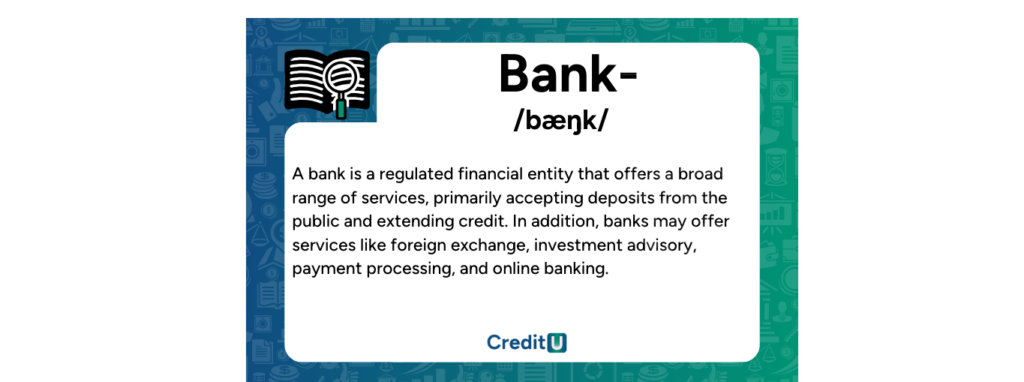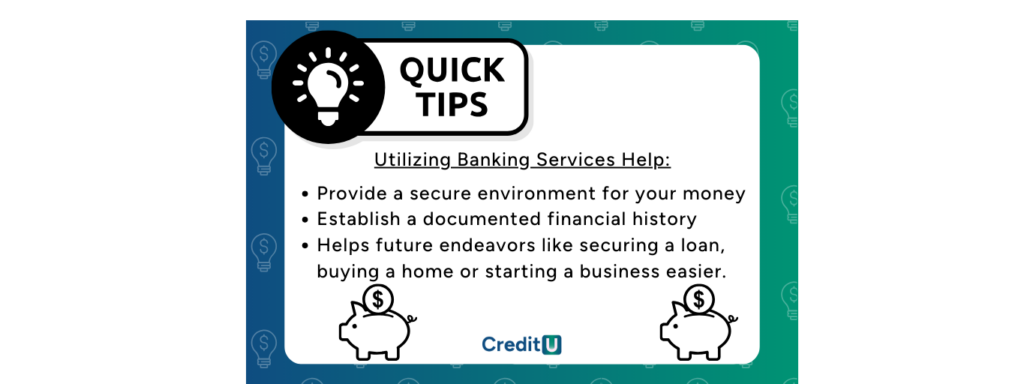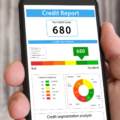Banking 101
July 20, 2023
Let’s talk about money. We all use it, save it, and sometimes worry about it. At the center of all this is something called ‘banking’. Think of banks as big financial toolboxes. They’re places where you can keep your money safe, get a little extra through interest, borrow when you need to, and even pay bills or buy things online. Banks are like our partners in managing money. Whether you’ve been using banks for years or you’re just getting started, understanding the basics can help you make the most of your money. In this article, we’ll break down the simple ABCs of banking and show how they play a big role in our day-to-day money matters. Ready? Let’s dive in!
Topics Covered... What is a Bank Types of Banking Services Steps to Opening a Bank Account Getting to Know Modern Banking Different Types of Banks Banking & Personal Finance What Can CreditU Do For You? Key Insights - Banking Basics
What is a Bank?
A bank is a financial institution licensed to receive deposits and make loans. Banks may also provide financial services such as wealth management, currency exchange, and safe deposit boxes. They play a vital role in the economy by providing the mechanism to make payments (e.g., through checking accounts, credit cards, or electronic transfers), safeguarding money, extending credit, and providing a wide range of other financial services to businesses, governments, and individuals.
Banks can be categorized into several types, such as retail banks, commercial banks, central banks, and investment banks, among others. They can also be differentiated based on ownership structure, such as public, private, or cooperative banks.
Types of Banking Services
In the vast world of finance, banks stand as pillars of support, helping individuals manage and understand their money. While many of us use banks regularly, diving deeper into the services they offer can unlock more efficient ways to handle our finances. Here’s a breakdown of the most basic services a banking institution offers.
-
Checking Accounts: The Heartbeat of Everyday Transactions
What are they?
A checking account serves as the primary reservoir for your money, facilitating daily transactions such as receiving salaries and paying bills.
Features:
Debit Card: This card isn’t just for withdrawing cash at ATMs. Use it for in-store purchases, online shopping, and more. It directly accesses the money in your account.
Overdraft Protection: Unexpected expenses? Overdraft protection can cover you but be cautious—this service often comes with fees. It’s not a long-term solution to cash shortfalls.
Online and Mobile Banking: Monitor your transactions, set up bill payments, and even deposit checks with a smartphone’s snap, all from the comfort of your home.
-
Savings Accounts: Your Money’s Growth Sanctuary
What are they?
A savings account is a financial tool designed for money preservation and gentle growth, segregating funds you wish to set aside from your everyday spending.
Features:
Interest: Earning power is a savings account’s superpower. Over time, you’ll see your money grow thanks to the magic of compound interest.
Withdrawal Limits: To maintain a high interest rate, banks often limit withdrawals. This restriction also helps deter impulsive spending.
Automatic Transfers: Simplify your saving habit. By automatically moving funds from checking to savings at regular intervals, you can steadily grow your savings without lifting a finger.
-
Loan Services: Fueling Your Big Purchases
What are they?
Loans empower you to make significant purchases or cover emergencies, offering you flexibility in managing large expenses.
Types of Loans:
Personal Loans: Whether you’re consolidating debt, funding a dream wedding, or dealing with unexpected expenses, personal loans offer a lump sum with fixed repayment terms.
Mortgages: A specialized loan for homebuyers, mortgages come with varied terms and interest structures. They’re often repaid over decades.
Auto Loans: Dreaming of a new car? Auto loans cater specifically to vehicle purchases, often with competitive interest rates.
Credit Cards: These versatile financial tools allow for revolving loans. While they offer rewards and convenience, it’s essential to manage balances responsibly to avoid high interest.
-
Additional Services: Beyond The Basics
Certificates of Deposit (CDs): Think of CDs as a timed savings vault. You deposit money and agree not to touch it for a set period, and in return, the bank offers a higher interest rate than regular savings accounts.
Money Market Accounts: A blend of savings and checking. They offer check-writing capabilities and usually come with higher interest rates. However, a higher minimum balance is often required.
ATM Services: Modern ATMs do more than give cash. Many accept deposits, offer print statements, and even provide language preferences.
Foreign Exchange: Traveling or doing international business? Banks can convert your money into various world currencies, ensuring you’re never left stranded in a foreign land.
Banks are more than mere vaults for our money; they’re dynamic institutions offering tools and services tailored for every financial need. You can better harness the power of your finances and steer your financial ship with confidence.
Steps to Opening a Bank Account
In the modern age, having a bank account is almost as essential as having an identity. It’s not just a safe place to store your money, but a financial management tool. Whether you’re thinking of opening your first bank account or switching to a new bank, understanding the process can be very helpful. Here’s a step-by-step guide to ease you into it.
1. Determine Your Needs:
Before heading to the bank, clarify what you want from your account. Understand why you are setting up the account in the first place.
Purpose: Is it for daily transactions, savings, or a special purpose like business or travel?
Features: Do you need online banking, ATM access, check-writing privileges, or overdraft protection?
Fees: Be wary of monthly fees, ATM charges, and other potential costs.
2. Research and Choose a Bank:
Not all banks are created equal. Do some in-depth research to choose the right institution for you. Check qualities like their reputation, customer service and the services the bank offers before you finalize.
Reputation: Check online reviews, Better Business Bureau ratings, or ask friends and family for recommendations.
Services: Ensure the bank offers the services and features you need.
Convenience: Consider branch locations, ATM accessibility, and online/mobile banking features.
3. Gather Required Documentation:
To open an account, you’ll typically need:
- Proof of identity (passport, driver’s license, state ID, etc.)
- Social Security Number or Individual Taxpayer Identification Number
- Proof of address (utility bill, rental agreement, etc.)
- Initial deposit, if required
Make sure you have all the documentation you need. You can receive this information by calling your bank’s customer service lines to make sure you have everything you need to set up your account.
4. Visit the Bank (or Apply Online):
While many banks now offer online account openings, some might require an in-person visit. If you are a brick and motor kind of person pay a visit to get the bearings. Talk to the staff personally and get answers to all the questions you have before setting up your bank accounts.
In-Person: Head to your chosen bank branch, take a token if needed, and wait for a representative to assist you.
Online: Visit the bank’s website and navigate to the account opening section. Follow the instructions, filling out your details and uploading any required documents.
5. Fill Out the Application Form:
Whether paper or digital, the application form will require:
- Personal details (name, date of birth, contact information, etc.)
- Employment details
- Information from your provided documents
- Choice of account type and features
A lot of your personal information will be requested in the application. Make sure you securely submit this information if you are going about this process online.
6. Deposit the Initial Amount:
Some accounts may require an initial deposit. Ensure you know the amount beforehand and have it ready if you’re opening the account in person.
7. Set Up Online/Mobile Banking (Optional but Recommended):
Most banks offer digital banking platforms. Setting this up will give you easier access to your money, allow for online transactions, and let you monitor your account on the go. Having this convenience can help you keep tabs easily about your money.
8. Understand Your Account’s Terms and Features:
Once your account is active, familiarize yourself with things such as:
- Monthly fees, if any
- Minimum balance requirements
- ATM withdrawal limits and charges
- Online transaction limits
- Overdraft policies
9. Secure Your Account:
Safety should be a priority. Banks offer many security steps such as PIN numbers, two-factor authentication etc. Make sure you familiarize yourself with all of the options and take necessary steps to secure your accounts.
- PIN Protection: Never share your ATM or debit card PIN.
- Online Safety: Use strong, unique passwords for online banking. Enable two-factor authentication if available.
- Alerts: Set up SMS or email alerts for transactions, helping you monitor any unauthorized activities.
Opening a bank account might seem daunting at first, but with proper research and preparation, it becomes a straightforward task. An account isn’t just about storing money, it’s a tool that, when understood and used wisely, can pave the way for a stable and prosperous financial future.
Getting to Know Modern Banking: Banking 101 Guide
Banking today is a mix of old habits and new tricks. While we still save money like we always have, the way we manage and use it has changed a lot, thanks to technology. This guide breaks down the basic parts of banking, making it easy for anyone to understand. Let’s explore what’s behind the bank’s doors and how it fits into our daily lives.
Deposits: The Financial Foundation
Every financial journey begins with a deposit. It’s the act of placing money into your bank account, securing it from potential risks like theft. But banking deposits are more diverse than one might initially think. From checking accounts that facilitate your daily transactions, to savings accounts that work behind the scenes to grow your money, or the more committed time deposits, which lock away funds for predetermined periods in exchange for higher interest rates. Each deposit type caters to different needs and financial goals, making it essential to choose wisely.
Loans and Credit: Empowering Financial Goals
Imagine wanting to buy a home or start a business but being short of funds. This is when banks step in, acting as financial bridges. Through services like personal loans for various needs, mortgages tailored specifically for real estate dreams, or credit cards that offer the flexibility of borrowing as and when required, banks empower consumers. These instruments allow individuals to achieve bigger dreams today, with a promise to repay them over time.
Interest: The Double-Edged Sword of Banking
At its core, a bank’s business revolves around interest. On one side, they reward customers by paying interest on their deposits. Think of it as a ‘thank you’ token for entrusting them with your money, especially evident in savings and time deposit accounts. On the flip side, when banks lend money, they charge interest. This is how they sustain their operations and ensure profitability. It’s essential for consumers to understand interest rates – the higher the rate, the more you earn on deposits or pay on loans.
ATMs and Digital Banking: The Convenience Revolution
Gone are the days when banking meant long queues and restricted hours. Automated Teller Machines (ATMs) dot the landscape, making cash accessible and facilitating simple banking tasks around the clock. But the real game-changer is digital banking. From the palm of your hand, you can now manage accounts, transfer funds globally, pay bills, and even apply for loans.
In essence, modern banking melds tradition with innovation, ensuring not just the safety of our money but also providing tools and services to maximize its potential. Whether you’re a seasoned financial expert or just starting your journey, understanding these basics is the key to unlocking many opportunities.
Different Types of Banks
The term ‘bank’ often conjures an image of a grand building where we deposit or withdraw money. However, the world of banking is much more varied than this singular picture. Different types of banks cater to different needs, ranging from personal savings to global trade. Let’s delve into the different varieties of banks and what sets each one apart.
-
Retail Banks:
Also known as consumer banks, these are the most common types that individuals interact with for their daily financial needs.
Functions: Accept deposits, offer checking and savings accounts, provide personal loans, mortgages, and credit cards.
Clients: Primarily individual consumers.
-
Commercial Banks:
These banks serve businesses, both big and small.
Functions: Business loans, credit services, merchant banking, and treasury and cash management.
Clients: Small businesses to large enterprises.
-
Investment Banks:
They play a crucial role in capital markets.
Functions: Assist businesses in raising capital, provide advisory on mergers and acquisitions, and engage in trading and market-making activities.
Clients: Corporations, institutional investors, and governments.
Central Banks:
These are the apex financial institutions in a country’s financial system.
Functions: Oversee monetary policy, issue currency, manage foreign reserves, and act as a lender of last resort.
-
Savings and Loan Associations (S&Ls):
Traditionally focused on savings accounts and mortgages.
Functions: Accept deposits and lend these out primarily for residential mortgages.
-
Credit Unions:
Member-owned financial cooperatives.
Functions: Offer many of the same services as retail banks but profits are returned to members in the form of reduced fees and higher interest rates.
Clients: Members who often share a common bond, such as employment or locality.
-
Online/Digital Banks:
21st-century banks operating without traditional physical branches.
Functions: Accept deposits, offer loans, and other standard banking services, typically with lower fees due to reduced overheads.
Clients: Tech-savvy individuals looking for convenience and competitive rates.
-
Merchant Banks:
Deal with commercial finance for multinational businesses.
Functions: Offer business loans, underwrite business debt, and facilitate international transactions.
Clients: Large corporations and high-net-worth individuals.
The world of banking is vast, diverse, and tailored to serve the intricate financial needs of society. From individual savings goals to mega-corporation investments, there’s a bank for every purpose. Understanding these types and their unique offerings can guide one in choosing the right banking partner for their financial journey.
Banking 101: Understanding the Role of Banking in Personal Finance
Cultivating Savings:
One of the cornerstone benefits of banking is how it nurtures your savings. Through interest-bearing accounts, your money doesn’t just sit idly; it grows. And when we talk about compound interest, the magic truly unfolds. Here, not only does your original sum (the principal) earn interest, but the accumulated interest does too. Over time, this results in a snowball effect, maximizing your savings growth.
Laying the Foundation with Credit:
Banks offer more than just a place to keep your money; they provide tools to enhance your financial standing. Using banking services like credit cards or loans consistently and responsibly allows you to establish and build a solid credit history. This creditworthiness translates to benefits down the line, like qualifying for lower interest rates and favorable borrowing terms when you need funds.
Ensuring Financial Safety:
In a world where uncertainties abound, banks offer a haven for your funds. Storing money in a bank shields it from potential theft, and with added layers of security, such as insurance from organizations like the FDIC, your deposits often have protection even if the bank faces difficulties.
Streamlining Finances with Digital Tools:
The digital age has reshaped banking, and with it, our approach to managing finances. Online banking platforms make it remarkably simple to oversee expenses, automate bill payments, and craft budgets. With real-time data at your fingertips, making informed financial decisions becomes second nature.
Venturing into the World of Investments:
Beyond the conventional, many banks have expanded to offer investment products and specialized advisory services. Whether you’re eyeing stocks, bonds, or retirement funds, these financial institutions can be gateways. With expert guidance, individuals can navigate investment avenues, ensuring not just savings but significant wealth growth and effective retirement planning.
Banking, in its essence, isn’t just an external service; it’s an integral part of our financial life cycle. By understanding its multifaceted role, one can harness its offerings to forge a path of financial stability and growth.
What Can CreditU Do For You?
If you’re new to the world of banking and personal finance, downloading an app like CreditU can help. CreditU is designed to help users track their spending, manage their finances, and improve their credit score. CreditU also gives you personalized finance tips tailored for your specific financial situation.
By using CreditU, you can get a better understanding of your current financial situation. The app allows you to connect your bank accounts and credit cards to the app, so you can easily see where your money is going and how much you are spending on different categories such as food, transportation, and entertainment. CreditU also provides insights into spending patterns.
Overall, if someone is new to managing your finances and wants to improve your financial literacy, downloading an app like CreditU could be a great first step. The app provides valuable tools and insights that can help you take control of your finances and make better financial decisions.
Key Insights -Banking Basics
1. A bank is a financial institution licensed to receive deposits and make loans. Banks may also provide financial services such as wealth management, currency exchange, and safe deposit boxes.
2. Finding the right financial institution and the right type of banking product has a lot to do with staying in line with your overall financial goals.
3. Banks facilitate a secure means to manage your money. Understanding the basics of banking helps move along in your financial journey.
4. Banking and personal finance go hand in hand to cultivate good money practices.
Back to the Top
Last Updated on January 11, 2024 by Dilini Dias Dahanayake











